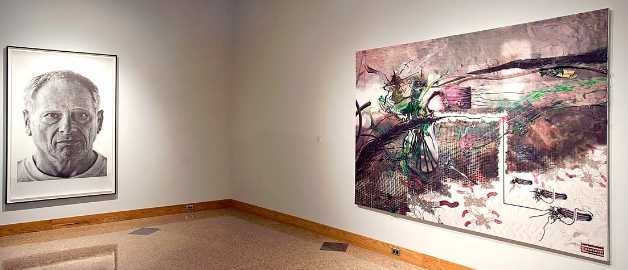Daum exhibit shows the computer’s versatile role in modern art
June 23, 2010 5:19 PM John Hansen The Sedalia Democrat
An artist using a computer to create art is nothing new, yet they are always using it to push boundaries.
At the Daum Museum’s “Virtual Media: Computer-aided Art from the Collection,” visitors can marvel at pieces that were obviously made digitally and others that seem traditional if you don’t know the story behind it.
“One of the things that makes this show interesting is some pieces you look at it and say, ‘That must’ve been made by a computer,’ but in other cases it would not occur to you,” said Daum director Tom Piche as he gave a visiting reporter a tour on Tuesday. “So artists have incorporated the ability of computers just as they would a pencil, a brush or a crayon. It’s one of many tools they use.”
In the art world, no one uses the terms “computer artist” or “traditional artist,” because those are not distinct categories.
“Several of the works here show that crossover very clearly,” Piche said. “And that’s why I wanted to call this ‘Computer-aided Art’ instead of ‘Computer Art,’ because I don’t think we call things ‘computer art’ anymore. The computer is so integrated into art-making that its just part of what they do.”
The eight pieces in “Virtual Media,” which can be found in the Goddard Gallery, include paintings, drawings, mixed media and even a sculpture. One drawing was made by a computer programmed by a human. One “painting” was created by a human using a computer and then printed with ink onto a canvas.
For the sculpture, the artist used a computer program to extract the colors in old paintings, then used those colors to make a three-dimensional mash-up that gave an impression of those paintings.
Computer-aided art has come a long way in the last 20 years. The oldest of the eight pieces in the Daum exhibit is from 1992.
“The history of computer art, of course, isn’t that long,” Piche said. “But it’s longer than people might think. Pretty much as soon as scientists started working with computers in the late 1950s, they began doodling with computers. And artists began experiments with computers in the 1960s, but it was difficult to do. You had to go someplace that had a computer, first of all. They were large and bulky and awkward contraptions.
“But with the revolution of the personal computer, a lot of artists were keen to develop the potential of computers. Not to experiment so much, but to make it a serious part of what they were doing.”
Piche recalled his first visit to a computer art exhibit in the late 1980s. At that time, “computer art” generally meant architectural drawings, and little else.
“Artists were using it in very flat ways that we would now consider to be kids’ stuff, because it was all so new, and what you could do was still pretty rudimentary,” Piche said.
Today, the computer is the most versatile tool in an artist’s toolbox.
One of the most eye-catching pieces in “Virtual Media” is a 2009 collage by Sedalia native Larry Thomas, who teaches at Johnson County Community College in Kansas. It’s the visual-art equivalent to what James Cameron did for movies with “Avatar.” “Poser’s Decoy” is on a flat canvas, but it looks three-dimensional thanks to a variety of tricks Thomas uses.
“Even though it’s a flat plain and a stretched canvas, you get the sense that we’re looking into something that has depth,” Piche said.
For more details about Thomas’ piece, see the video on the Swoop page.
In addition to “Virtual Media,” Daum visitors can check out “Arboresque” in the upstairs gallery. It’s a selection of two- and three-dimensional works from the permanent collection centered around trees and the natural world.
But, if you need more proof that computers are now a ubiquitous art tool, one of the nature drawings was created in a computer.
If you go
What: “Virtual Media: Computer-aided Art from the Collection” and “Arboresque”
When: Through Sept. 5
Hours: 11 a.m. to 5 p.m. Tuesdays through Fridays and 1 to 5 p.m. Saturdays and Sundays
Where: Daum Museum, State Fair Community College, Sedalia
Admission: Free
